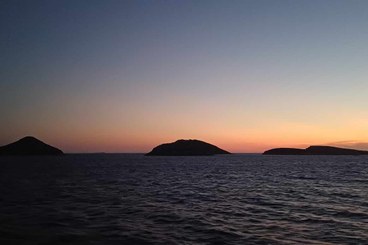
By Vasiliki Makrygianni
During the summer of 2024, I embarked on an introductory field trip to the Greek-Turkish Border Archipelago. Over this research journey, I visited islands, Closed Controlled Access Centers (CCACs), several coastal landing spots, and various NGO offices. I engaged in formal and informal conversations with refugees, NGO workers, camp managers, lawyers, teachers, locals, solidarians, and state and municipal authorities. This research trip provided an introductory overview of the Greek Border Archipelago’s critical role in migration trajectories, highlighting the interplay between historical legacies, evolving infrastructures, and the diverse actors engaged in refugees’ movements and daily lives.
My research began on the island of Leros, where I arrived in Lakki on June 10 after an 11-hour boat trip from Piraeus. I chose Leros as my starting point due to its emblematic role in the Greek history of institutionalization processes. In Lakki, one of the deepest Mediterranean ports and a major naval base for Italy during World War II, I explored old Italian administrative and military infrastructure, such as the PIKPA and Lepida area, which the Greek state later repurposed for various uses, including as a refugee place of stay and a hotspot from 2017 to 2020. I visited the General State Archives to gather relevant material and met with a municipal official and local solidarians, who provided a thorough overview of the island's past and current refugee receptions. Refugee presence was noticeable in certain areas of Lakki, and I held several conversations with people on the move regarding their daily lives. At that time, only a few migrant-related NGOs were active on the island. On June 14, I departed for Kos to attend the Antiracist Festival, held from June 15 to 17.
On July 17, I arrived on the island of Crete. As migratory routes started shifting, I added Crete to my research itinerary to observe developments along this new route and the island’s infrastructure. I arrived in Chania, where I met with local solidarians, lawyers, and a cultural mediator who provided insights into the current situation, including refugee arrivals on the islands of Gavdos and various points in Crete. Since there are no CCACs on Crete, informal makeshift spaces often emerge to detain refugees upon arrival. These temporary arrangements reflect the authorities’ adaptive responses to changing migration patterns.
On August 20, I traveled to Samos, spending nine days primarily in Vathi. During this time, I visited the Samos CCAC, NGO offices, and facilities offering legal aid and care, such as La Maison and We Have Rights. I had an informative discussion with the mayor at the municipality and extensive discussions with locals and NGO workers, gaining a deeper understanding of the island’s multiple crises, including those stemming from a recent earthquake. Conversations with refugees in public spaces, particularly in Kipos Park, provided valuable perspectives on their daily lives and the conditions at the CCAC. Additionally, I explored the remnants of the old hotspot near Vathi, where traces of its history remain visible. My visit to Samos was briefly interrupted by a trip to Leros from August 25 to 28 to visit the Leros CCAC. The 18-hour round-trip boat journey offered a unique perspective on the Southern Aegean Archipelago’s landscape and seascape.